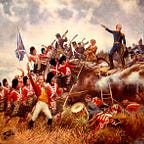President Putin’s Ukraine Disaster: What Went Wrong?
It has been suggested by some that President Putin is on the verge of victory in Ukraine. Those who take this line seem to believe that Mr. Putin is engaged in a five-dimensional chess strategy and that it will pay-off in the end. Perhaps they are right, but the simpler explanation is that Mr. Putin’s invasion is a colossal disaster.
Let’s break down everything the Russians screwed up.
On February 24th, the Russians invaded, and there were multiple avenues of attack. Three were directed at Kiev, one through Kievskaya Oblast through the Chernobyl Exclusion Zone, the second through Chernigov, and a third coming from the direction of Bryansk.
Another group of Russians attacked Kharkov, and another group attacked north, east, and west out of Crimea.
You don’t have to go to be a staff college genius to see the problem with this.
The Russians launched an invasion of a country larger than Texas with no main effort. Normally, an objective is picked and a main effort is put together with sufficient mass to achieve said objective. To prevent the enemy from massing against your main effort, you can have two or three supporting efforts.
But not the Russians.
They attacked all over the place in insufficient mass, expecting the Ukrainians to rip off their uniforms, flee in terror, or surrender en masse like Iraqis.
But the Ukrainians stood and fought.
Most people thought they wouldn’t, even many Ukrainians I know, but they did and inflicted high casualties on the Russians.
One can forgive the Russians for underestimating the combat effectiveness of the Ukrainian army (hell, everyone did), but the attack through the Chernobyl Exclusion Zone was stupidly unforgivable.
The Russians went through the Exclusion Zone with tanks and mechanized infantry and paras landing at the airport in Gostomel ahead of them. From there, they thought they would parade into Kiev.
Anyone who knows anything about the Exclusion Zone or the general area north of Kiev knows it’s not tank country. It’s deep and impenetrable forest, swamps, and rivers, and there are only two roads leading out of Ivankov that can be used by heavy vehicles.
When you’ve achieved tactical surprise, your battalion tactical groups may be able to roll down those roads unopposed at 70 mph, but whatever goes down those roads needs to be resupplied, and that’s not going to happen on one or two roads leading in one direction and no connecting roads. Whatever sustainment units the Russians had supporting this attack likely got stuck in traffic jams because they didn’t have space to deliver their supplies, turn around, and go back the other way.
Getting back to those battalion tactical groups, attacking from Chernobyl to Kiev via Ivankov may have solved the operational problem of Kiev’s distance from the Russian border, but it created a new problem; the inability to manoeuvre once they reached Kiev’s outskirts.
Again, it’s roads and terrain.
From Bucha and Irpin the only ways into Kiev is the E-373 and P-30 running north west to south east. From Vyshgorod there is Minskiy Prospekt and Bogatyrskaya Street running north to south. Whenever a book is written about the war, there will be a passage saying the Russians got stacked up on those roads and couldn’t move.
Why?
Because either side of those roads are dense forests and urban developments, inhibiting a mechanized army’s ability to manoeuvre.
When the Russians realized they couldn’t get into Kiev directly, they tried going south to cut the Zhitomir Highway.
Again, they experienced the same problems with roads leading in one direction and dense forests, and the new problem of muddy fields as the forest grows less dense further south along the route of advance. The Russians got stacked up, shot up, and they had nowhere to go but backwards.
Former Marine Corps intelligence officer Scott Ritter believes this attack was a diversion from the main effort in Donbas. If he is correct, which I doubt, it was a poorly executed diversion that failed in its objective, as the Ukrainians still control much of the region.
How could the Russians, who gave us military geniuses like Alexander Suvorov and Georgiy Zhukov, execute this war so stupidly?
Because their Suvorovs and Zhukovs didn’t plan this war, President Putin and his political advisors did, basing their beliefs on lousy intelligence provided to them by the FSB’s Fifth Department.
President Putin and his advisors believed Ukrainian army was not fit for purpose, wouldn’t fight for President Zelenskiy, and the Russian-speaking population would welcome their liberators with open arms. This belief explains why Mr. Putin believed he could mount a successful invasion during the muddiest period of the year.
Only people don’t fight for presidents, ideologies, or linguistics, they fight for hearth and home.
The Ukrainians are still likely to lose this war despite President Putin’s best effort to help them win. They are running out of fuel, and considering their pleas for anti-tank weapons, planes, tracked vehicles, and anti-aircraft weapons, they are running out of those, too. The quantity of men and weapons the Russians have will be the deciding factor.
But it will be an embarrassing pyrrhic victory that cost the Russians over 10,000 casualties, hundreds of tracked and wheeled vehicles, and dozens of fixed winged and rotary aircraft— if not more.
President Putin is not playing four-dimensional chess with anyone. Instead, he is throwing crap at the wall and hoping something sticks. Unfortunately for Ukraine, he has a lot to throw.
